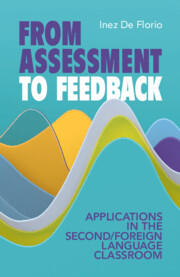117 results
Chapter 3 - The Carbon Cycle and Climate Change
- from Part I - Introduction and the Physical Environment
-
- Book:
- Ecology in Action
- Published online:
- 04 April 2024
- Print publication:
- 04 July 2024, pp 52-76
-
- Chapter
- Export citation

First Language Acquisition
- Coming soon
-
- Expected online publication date:
- June 2024
- Print publication:
- 20 June 2024
-
- Textbook
- Export citation
Chapter 7 - Personal Intelligences
- from Part II - Transition Expertise
-
- Book:
- Transition Expertise and Identity
- Published online:
- 30 May 2024
- Print publication:
- 06 June 2024, pp 110-144
-
- Chapter
- Export citation
Feedback thought at the intersection of systems and design science
-
- Journal:
- Proceedings of the Design Society / Volume 4 / May 2024
- Published online by Cambridge University Press:
- 16 May 2024, pp. 13-22
-
- Article
-
- You have access
- Open access
- Export citation
Fostering Education in Epilepsy: A Canadian League Against Epilepsy Teaching Initiative
-
- Journal:
- Canadian Journal of Neurological Sciences , First View
- Published online by Cambridge University Press:
- 25 March 2024, pp. 1-6
-
- Article
-
- You have access
- Open access
- HTML
- Export citation
10 - Feedback and Control
-
- Book:
- Quantum Measurement
- Published online:
- 10 May 2024
- Print publication:
- 15 February 2024, pp 218-232
-
- Chapter
- Export citation
Feedback quality and divided attention: exploring commentaries on alignment in task-oriented dialogue
-
- Journal:
- Language and Cognition , First View
- Published online by Cambridge University Press:
- 11 January 2024, pp. 1-29
-
- Article
-
- You have access
- Open access
- HTML
- Export citation
3 - Why, when, and how (much) should I correct my learners?
- from Part I - Teacher and Student Talk
-
- Book:
- The Art and Science of Language Teaching
- Published online:
- 21 December 2023
- Print publication:
- 21 December 2023, pp 34-47
-
- Chapter
- Export citation
9 - Modelling Sustainable Development
- from Part IV - Understanding Sustainable Development
-
- Book:
- Sustainability Science
- Published online:
- 07 December 2023
- Print publication:
- 07 December 2023, pp 194-230
-
- Chapter
- Export citation
Assessment for learning of paediatric cardiology trainees in 41 centres from 19 European countries
- Part of
-
- Journal:
- Cardiology in the Young / Volume 34 / Issue 3 / March 2024
- Published online by Cambridge University Press:
- 29 August 2023, pp. 588-596
-
- Article
-
- You have access
- Open access
- HTML
- Export citation
2 - From Tiny to Small
- from Part I - The Basics of Creativity
-
- Book:
- The Creativity Advantage
- Published online:
- 27 July 2023
- Print publication:
- 29 June 2023, pp 19-30
-
- Chapter
- Export citation
Backchannels in conversations between autistic adults are less frequent and less diverse prosodically and lexically
-
- Journal:
- Language and Cognition / Volume 16 / Issue 1 / March 2024
- Published online by Cambridge University Press:
- 21 June 2023, pp. 108-133
-
- Article
-
- You have access
- Open access
- HTML
- Export citation
Chapter 6 - Supporting Mental Model Construction
-
- Book:
- Handbook of Augmented Reality Training Design Principles
- Published online:
- 18 May 2023
- Print publication:
- 01 June 2023, pp 76-90
-
- Chapter
- Export citation
18 - Starburst Galaxy NGC 253
- from Part VI - External Galaxies
-
- Book:
- Case Studies in Star Formation
- Published online:
- 11 April 2023
- Print publication:
- 13 April 2023, pp 281-294
-
- Chapter
- Export citation
6 - Physics: Exploring Pluriliteracies through a Deeper Learning Episode on Rainbows
- from Part II - Deeper Learning Episodes: First Steps towards Transforming Classrooms
-
-
- Book:
- A Deeper Learning Companion for CLIL
- Published online:
- 04 February 2023
- Print publication:
- 23 February 2023, pp 49-96
-
- Chapter
- Export citation
10 - Where to Go Next
-
- Book:
- Second Language Acquisition
- Published online:
- 03 February 2023
- Print publication:
- 26 January 2023, pp 301-324
-
- Chapter
- Export citation

From Assessment to Feedback
- Applications in the Second/Foreign Language Classroom
-
- Published online:
- 19 January 2023
- Print publication:
- 19 January 2023
Outcome feedback reduces over-forecasting of inflation andoverconfidence in forecasts
-
- Journal:
- Judgment and Decision Making / Volume 17 / Issue 1 / January 2022
- Published online by Cambridge University Press:
- 01 January 2023, pp. 124-163
-
- Article
-
- You have access
- Open access
- HTML
- Export citation
The effects of behavioral and outcome feedback on prudentdecision-making under conditions of present and futureuncertainty
-
- Journal:
- Judgment and Decision Making / Volume 1 / Issue 1 / July 2006
- Published online by Cambridge University Press:
- 01 January 2023, pp. 76-85
-
- Article
-
- You have access
- Open access
- HTML
- Export citation



